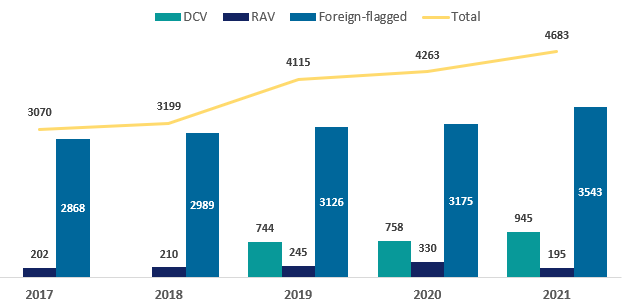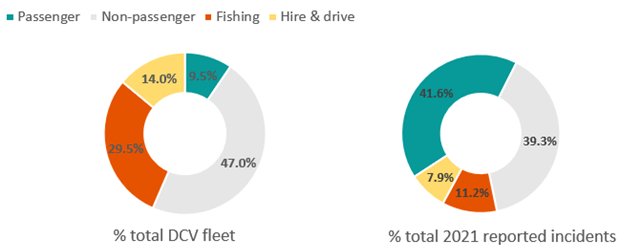Increases in reported marine incidents
Reporting of marine incidents and ensuing control measures put in place to prevent re-occurrence is indicative of a good reporting and maturing safety culture. In 2021, marine incident reporting continued to increase over previous years, which suggests improvement in reporting culture in the commercial vessel industry as a whole. In spite of this positive trend the maritime industry generally still suffers from widespread underreporting of marine incidents, which presents a challenge for AMSA as a safety regulator, as incident reporting is one of the more important safety improvement strategies.

Reporting trends in DCVs
Marine incidents are classified by AMSA into one of three severity levels: very serious, serious, and less serious. In 2021 for DCVs, less serious incidents comprised 70.6% of all reported incidents. This is consistent with 70.3% in 2020.
Considering DCVs by class, number of reports received from passenger and non-passenger vessels increased whilst the number reported by fishing and hire & drive vessels remained steady. Passenger vessels reported a much larger share of incidents compared to their share of the DCV fleet, suggesting that the operators of passenger vessels continue to have a better reporting culture. Fishing vessels continue to have a much smaller share of reported incidents compared to their representation in the DCV fleet (figure 2) and from the reports that are received, they rate of very serious and serious incidents is nearly double that of the other vessel classes.

There was also a lower proportion of incident reports from vessels under 7.5m in length, which form the majority of the DCV fleet.
AMSA recognises there are issues to be addressed to foster a positive reporting culture among operators of smaller vessels and fishing vessels and will continue to work with operators of these vessels to improve reporting culture.
Reporting trends in foreign-flagged and regulated Australian vessels (RAVs)
Low numbers of vessels and therefore reports mean RAV data lacks statistical significance to support trend analysis.
In foreign-flagged vessels in 2021, less serious incidents comprised 92.6% of all reported incidents.
Bulk carriers reported the majority of incidents and were over-represented in incident reports compared to vessel arrivals. Bulk carriers together with vehicle carriers reported a lower proportion of very serious and serious incidents compared to the average for foreign-flagged vessels. The highest proportion of very serious and serious incidents were reported by livestock carriers and ‘other’ ship types including tug boats, wood-chip carriers, special purpose ships, heavy load carriers, ro-ro cargo ships and NLS, oil/chemical and oil/NLS tankers.